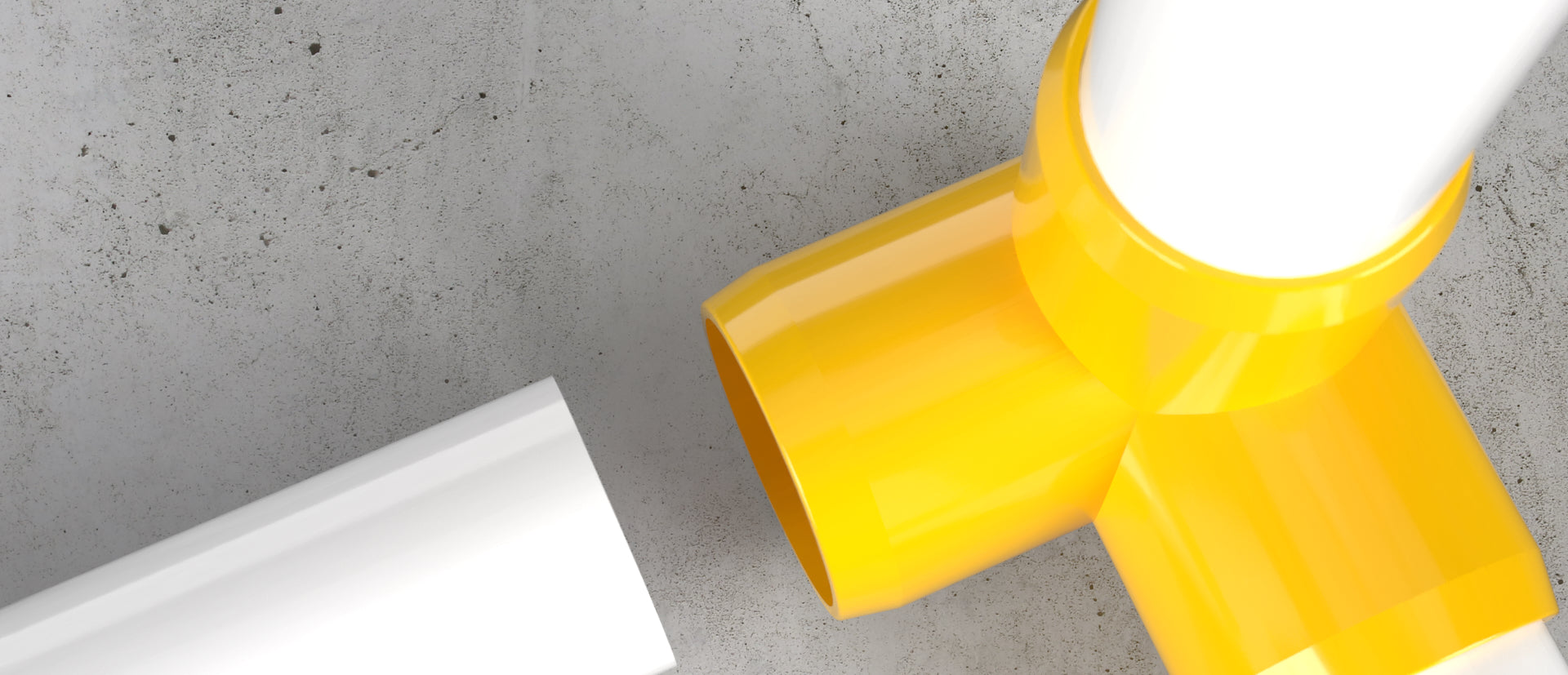
Two Ways to Connect PVC Pipe and Fittings
You already know how easy it is to build with PVC pipe, but there is one crucial step to making sure that your structure is strong and secure - connecting everything together, which is just as easy.
Assembling your PVC Project
There are two ways for connecting PVC pipe and fittings together for a structural project. They are the PVC solvent (cement) method, and the fastener connect technique. Both versions work well, but we ALWAYS recommend using PVC cement, as it is the most secure and permanent answer.
Connecting PVC Pipe and Fittings via PVC Solvents
Using PVC Cement
Connecting PVC pipes to fittings using PVC cement is not simply a matter of "gluing"; it's actually a welding process. PVC cement effectively melts the plastic surfaces, and within approximately 30 seconds, it forms a permanent bond, fusing them together. This welding technique is advantageous as it transforms your PVC components into a unified, robust structure, enhancing their strength as a cohesive unit.
Here's a step-by-step guide on how to effectively join PVC using PVC cement:
FOR EXTERNAL FITTINGS
- Conduct a Test-Fit.
Before applying any cement, perform a test-fit to ensure that the components align correctly and fit together as desired. - Clean Both Components.
Make sure that both the pipe and fitting are thoroughly clean, free from any dust, dirt, or contaminants. This step is crucial for a strong bond. - Apply PVC Cement.
Apply a small amount of PVC cement to the interior of the fitting, specifically where the 'stop' or detent is located. The stop is the small lip inside the fitting where the pipe will ultimately be seated. - Insert the Pipe.
Gently insert the pipe all the way into the fitting, making sure it seats securely against the stop. Hold the pipe in place for approximately 30 seconds to allow the cement to create a strong bond. - Use Assistance if Needed.
If the pipe does not insert fully by hand, you can use a mallet or a piece of wood to gently tap the pipe into place. Be cautious not to apply excessive force.
FOR DOME CAPS AND COUPLINGS
When working with dome caps and couplings, follow these steps for a proper connection:
- Start with Steps 1 and 2 as outlined above.
- Apply PVC Cement to the Pipe.
Apply a small amount of PVC cement to the interior of the PVC pipe. Be cautious not to apply any cement to the end of the coupling or dome cap. - Insert the Coupling or Dome Cap.
Gently insert the coupling or dome cap into the PVC pipe. Ensure it goes in securely but refrain from applying PVC cement to the component's end. - Secure the Connection.
If the coupling or dome cap doesn't insert fully by hand, you can use a mallet or a piece of wood to tap it into place. Exercise care not to use excessive force. - Allow for Curing.
After securing the connection, let it sit for approximately 30 seconds to allow the PVC cement to cure and create a strong, durable bond.
Connecting PVC pipe and Fittings with Screws
Using Screws to Connect PVC
You can create a temporary yet secure connection between PVC pipes and fittings by using threaded screws, to provide a robust structural hold without the permanent bonding of PVC cement. This method offers the flexibility to reuse or reposition fittings later on.
It's a valuable approach for connecting PVC, but it comes with certain limitations. It may not match the strength of PVC cement, and it's not suitable for components with an internal fit, such as couplings and dome caps. Here's a step-by-step guide on connecting PVC using fasteners:
- Insert the Pipe into the Fitting.
Ensure that the PVC pipe is fully seated inside the fitting, and if needed, use a mallet to ensure complete insertion. - Create a Pilot Hole.
Use a 1/8" drill bit to create a pilot hole approximately midway between where the pipe and fitting meet on the side of the fitting. This hole will facilitate the insertion of the screw. - Insert the Screw.
Utilizing a power drill or driver, insert a self-tapping threaded screw into the pilot hole you just drilled. Make certain that the screw is long enough to go through both the fitting and the pipe.
By following these steps, you can securely connect PVC components using fasteners, allowing for a robust but removable connection, especially suited for projects that require flexibility and repositioning
Assembly Notes
Both the methods outlines above will work to make your PVC structure sound and strong and give them a lifetime of use.
Push-to-Connect.
If neither of the methods above sound like something you wish to do, you can push pipe and fittings together, and in many cases they will remain connected, however due to variances in manufacturing, you may end up with pieces that are too loose. If this is the case, we recommend that you at least use the fastener connection technique to join any loose elements.
